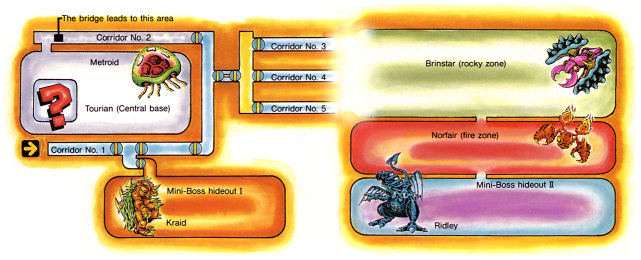Metroid
Also Known As
- メトロイド - Japanese spelling
Genres
Overview
Metroid is an action/adventure game first released by Nintendo in 1986 for the Famicom Disk System and the following year in cartridge format for the Nintendo Entertainment System. The game is the first entry in the long running Metroid series and helped pioneer the Metroidvania gameplay style that emphasises exploration and locating power-ups in order to reach new and formerly inaccessible areas. In the game players take on the role of bounty hunter Samus Aran as she explores the planet Zebes in order to stop space pirates from turning the parasitic creatures known as Metroids into weapons.
Story and Gameplay
Metroid takes place in the year 20X5 after Space Pirates attack a vessel and seize samples of the parasites called Metroids which were located on planet SR388. The Metroids are extremely dangerous; they can rapidly drain any life form of it's energy and kill it. The Space Pirate's plan is to use beta rays to replicate them and turn them into a weapon which will threaten the safety of the entire galaxy. The Galactic Federation attempted an assault on the planet Zebes, the Space Pirates home base, but failed. As a last resort they are sending in bounty hunter Samus Aran with the mission of stopping the Space Pirates and the controlling force, Mother Brain.
The game uses a side view of the planet Zebes with players controlling Samus Aran. Rather than being made up of individual levels, the entire game world consists of a single, large, interconnected map with numerous platforms, doors, and elevators. Not all locations are initially accessible; players will need to acquire certain items such as weapon or ability power-ups first in order to reach many areas. Doors come in several varieties; blue doors can be opened with a single blast from any weapon, red ones take 5 missiles and other colors take 10 missiles. Elevators are used to travel into new regions of Zebes; if players lose a life the game is over but they may continue again from either the game start or the location of the last elevator taken. Backtracking may also be necessary as revisiting some areas after an upgrade has been acquired will allow something new to be found. The planet Zebes is extremely hostile with various alien life forms found throughout, many of which will attack Samus and all of which are dangerous to touch. Additionally some areas have deadly water; if Samus falls off of a platform into the water energy will be drained rapidly! Destroying enemies will sometimes leave items behind; these will either restore a small amount of energy or provide additional missiles (up to Samus' maximum capacity).

At the start of the game Samus has only a limited amount of capabilities, the ability to jump and a weak power beam as a weapon. By exploring the planet players will be able to locate additional power items that upgrade Samus' abilities. These items include the following:
- Long Beam:
Boosts the range of Samus' weapon, allowing shots to travel across the entire screen. - Ice Beam:
Temporarily freezes opponents. When frozen, enemies can be touched and used as platforms. - Wave Beam:
Wave shaped shots that inflict more damage than the other beams. - Screw Attack:
Allows Samus to inflict damage to opponents while performing a somersault. - High Jump Boots:
Increases the height Samus can jump. - Varia Suit:
Reduces the amount of energy lost when attacked. - Maru Mari:
More commonly known as the Morph Ball, allows Samus to travel through narrow passageways. - Bombs:
Only usable while in ball mode, bombs can destroy some wall blocks to reveal passages. - Energy Tank:
Increases Samus' maximum energy capacity. - Missile Rocket:
Increases Samus' missile storage capacity.
Metroid allows players to save their progress as the game likely isn't completable in one sitting for most players. The original Famicom version allowed games to be saved to disk, however since this wasn't possible for later cartridge versions they instead used a 24 character password.
Endings
Metroid is one of the first games to contain multiple endings; there are a total of five different endings possible which are selected based on the amount of time it takes players to complete the game. In two of the endings, Samus will remove her suit for the first time which is when it's revealed Samus is a woman. This was a twist at the time with even the instruction manual referring to Samus as he in order to preserve the surprise; While not the first female protagonist, she is still one of the earliest and most famous.
Credits
|
Platform:
NES / Famicom
|
||
| Scenario Written by: | Makoto Kanoh (as Kanoh) | |
| Character Designed by: | Hiroji Kiyotake (as Kiyotake), Hirofumi Matsuoka (as New Matsuoka), Yoshio Sakamoto (as Shikamoto) | |
| Music by: | Hirokazu Tanaka (as Hip Tanaka) | |
| Main Programmed by: | Hiroyuki Yukami (as Hai Yukami), Yase Sobajima (Zaru Sobajima), Toshio Sengoku (as GPZ Sengoku), N. Shiotani, M. Houdai | |
| Special Thanks to: | Ken Zuri, Sumi, Toru Osawa (Inusawa), Kacho, Hyakkan, Goyake, Takahiro Harada (as Harada), Penpen, Tohryu Restaurant [Tohryu], Sometime Mako Restaurant [Mako], Benkei Dining [Benkei] | |
| Converted by: | Toru Narihiro (as T. Narihiro) | |
| Assisted by: | Makoto Kanoh | |
| Directed by: | Yoshio Sakamoto (as Yamamoto) | |
| Chief Director: | Satoru Okada | |
| Produced by: | Gunpei Yokoi | |
| Executive Producer: | Hiroshi Yamauchi | |